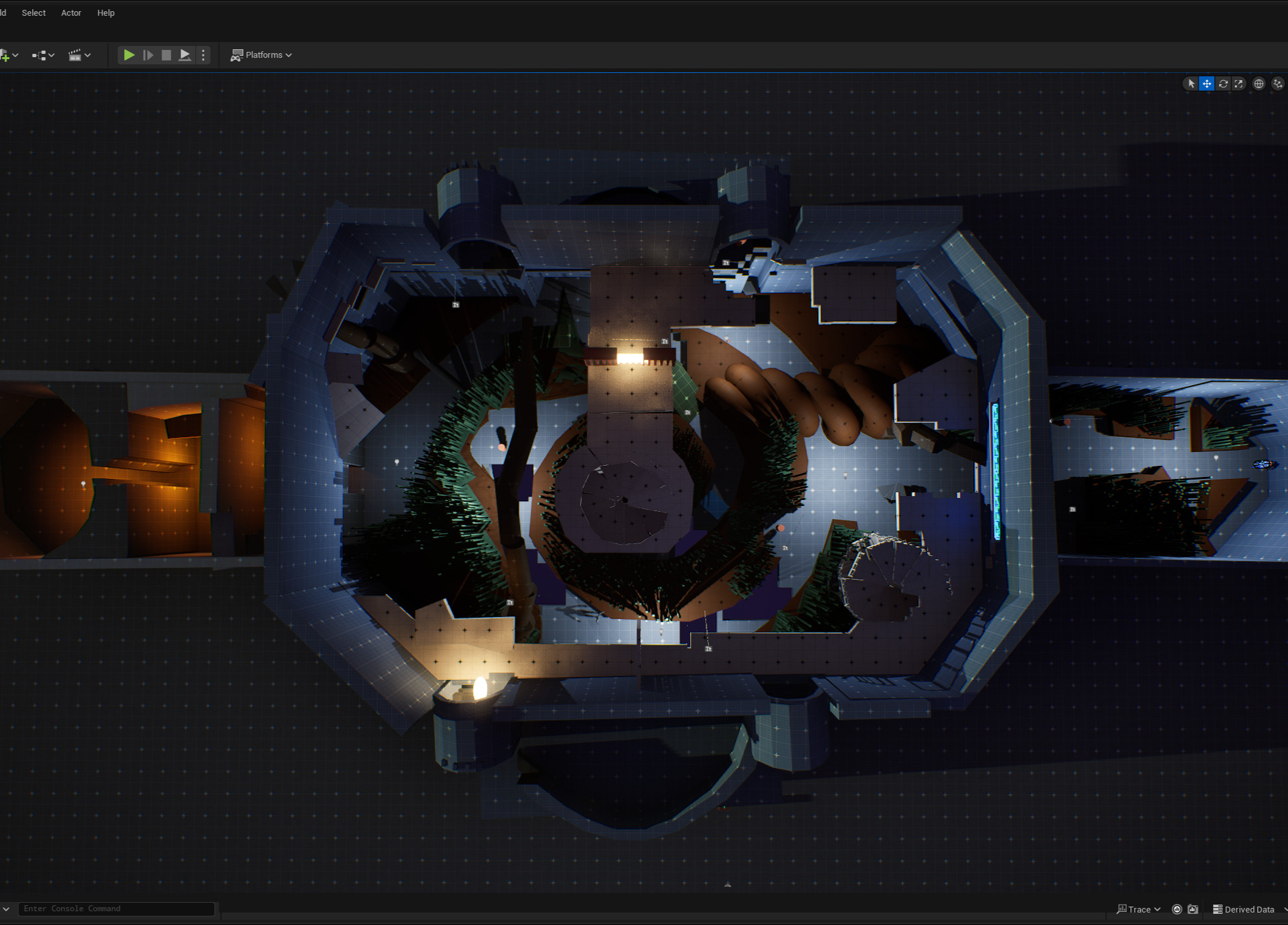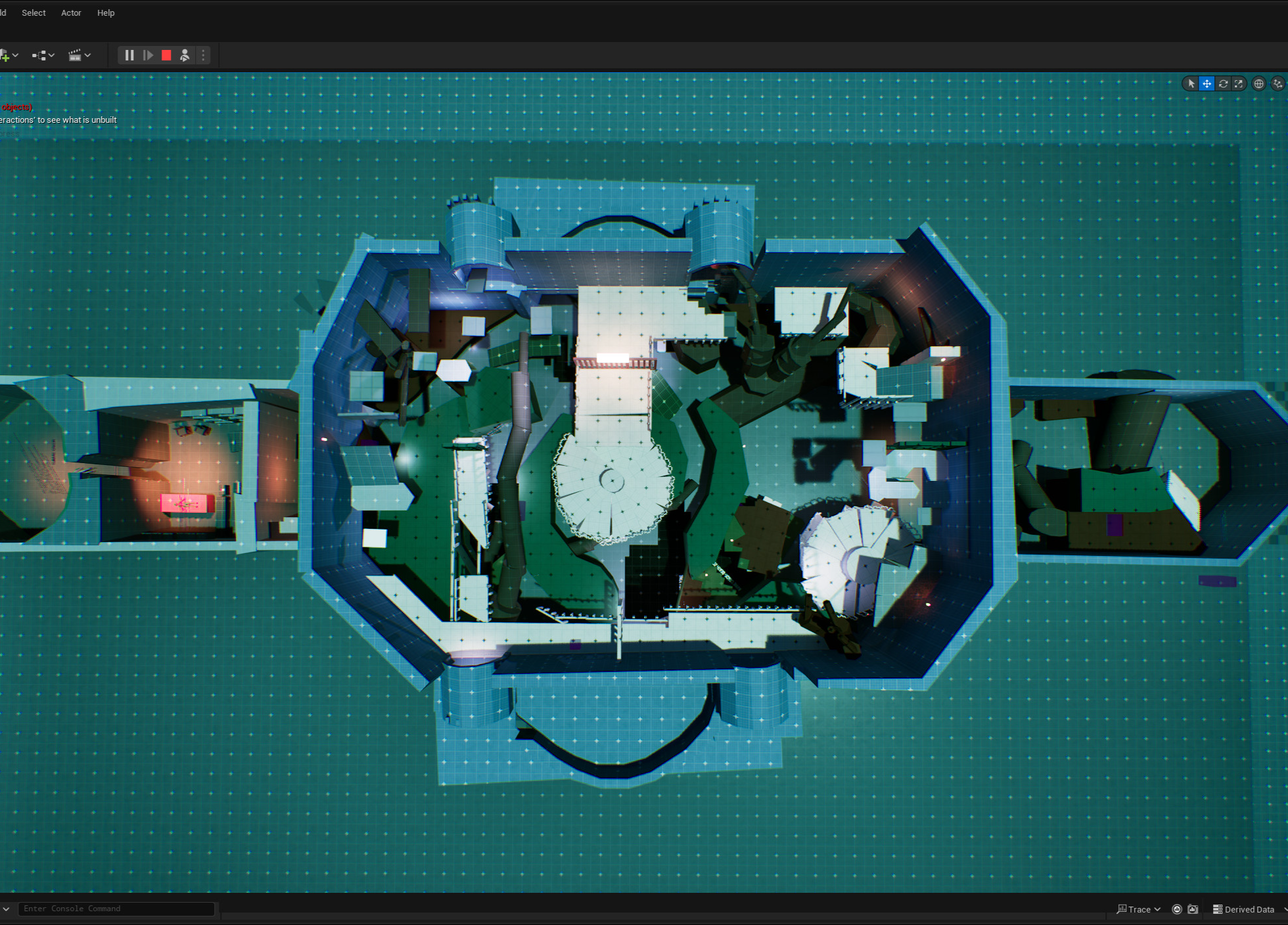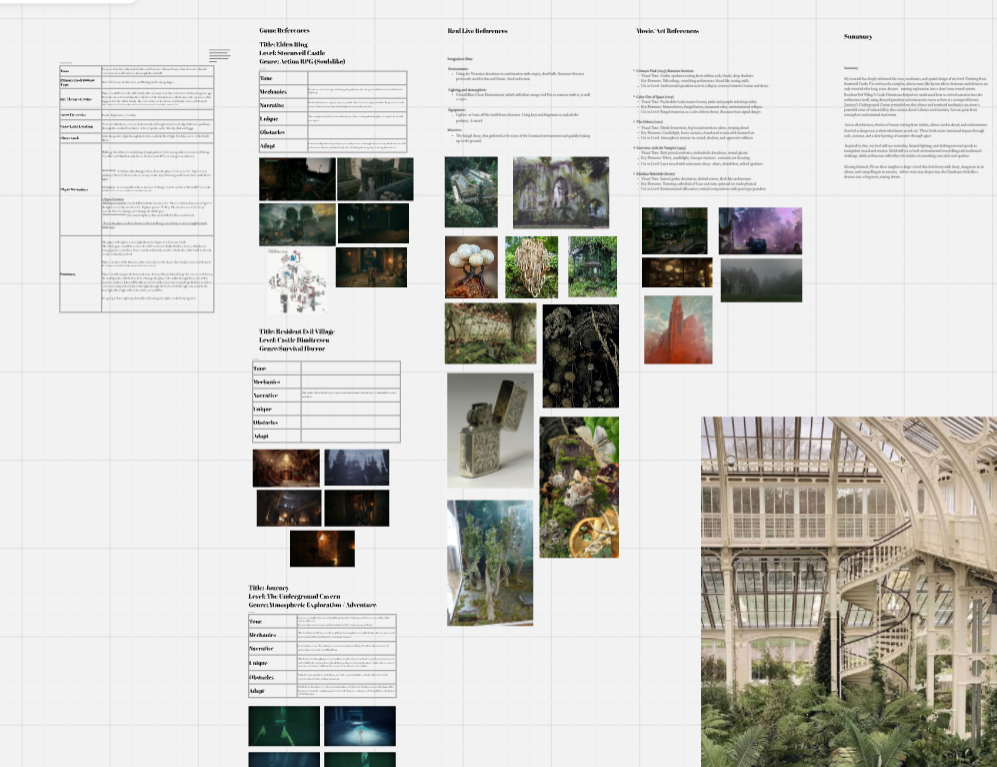Glasshouse Level Blockout
Genre: 3D Action Adventure / PvE
Type: Blockout
Engine: Unreal Engine 5
Tools: JakubW, Miro, Notion
Iterations # 6
Playtests # 5
Role:: Level designer (research and concept, blockout, scripting, encounter design)
Overview
Layout
Version 1
Version 2
Version 3
Version 4
Verstion 5/6
Goal
For Glasshouse, my goal was to experiment within Unreal Engine and push the potential of its blockout tools beyond my previous projects. I wanted to implement techniques I had never used before, exploring how new workflows could elevate both design quality and iteration speed. This project served as a testing ground for substantial research and experimentation—each stage of development became an opportunity to prototype, analyze, and refine ideas in practice. My intention was to create a level that not only demonstrates technical growth, but also clearly showcases the iterative process behind its evolution.
Level Overview & Technique Highlights
Throughout the blockout process, I applied multiple design techniques with the goal of creating an engaging and immersive player experience. I focused on combining looping layouts, narrative storytelling, and visual guidelines to guide player flow and reinforce the atmosphere of the level. Each technique was tested through numerous iterations and adjustments, ensuring that every change contributed meaningfully to pacing, readability, and emotional impact. This iterative approach allowed me to refine how these techniques interacted—balancing structure, storytelling, and player agency within the evolving space of Glasshouse.
Visual Guidelines and Foreshadowing



I utilized the Visual Guidelines technique to subtly direct player movement and reinforce spatial awareness throughout Glasshouse. By carefully framing pathways with lighting, geometry, and environmental contrast, I guided the player’s attention toward key routes and points of interest without relying on overt indicators. Strategic placement of light sources highlighted doorways and traversal paths, while architectural framing created vistas that revealed important landmarks and allowed players to plan their next steps. This approach helped maintain immersion and ensured that exploration felt intuitive, visually driven, and grounded in the world’s atmosphere.
Looping



I implemented the Looping Level Design technique to create a cohesive and satisfying sense of progression within Glasshouse. The core of this loop revolves around a blocked gate, which acts as both a traversal challenge and a narrative beat. Upon encountering it, the player is encouraged to explore alternative routes through the decayed mansion - uncovering fragments of its lore and discovering environmental storytelling elements along the way. Eventually, the player activates a lever that opens the previously blocked gate, completing the loop and allowing traversal back through a now-familiar space. This design not only reinforces spatial understanding but also creates a rewarding rhythm of exploration, discovery, and return.
Environmental Storytelling



I incorporated Environmental Storytelling to strengthen the narrative and emotional tone of Glasshouse. Through the use of colour and lighting, I established a dark, haunting, and mysterious atmosphere that reflected the world’s decaying beauty. The environment itself became a storyteller - supported by narrative encounters with NPCs and dialogues that revealed fragments of the mansion’s past and the origins of its fungal corruption. My goal was to maintain a sense of realism and believability within the space, while still embracing a fantastical edge that allowed the setting to feel otherworldly yet grounded. This balance helped the level convey story and emotion organically through its spaces, light, and interactions.
Walkthrough
Process Breakdown
Iteration Overview




1: Research, Ideation & Planning
Miro Board used for Inspiration
I conducted extensive research across games, architecture, and visual media to shape the concept and tone of Glasshouse, laying the foundation for the Level Design Document (LDD).
Game Analysis: Drew from Elden Ring’s Stormveil Castle for vertical, maze-like layouts and shortcut design; Resident Evil Village’s Castle Dimitrescu for gothic opulence and stalker tension; and Journey’s Underground Cavern for eerie stillness and restricted movement.
Real-World References: Studied Victorian and decayed glasshouses, abandoned mansions, and overgrown ruins like Angkor Wat to capture the tension between structure, decay, and nature’s reclamation.
Other Media: Took inspiration from Crimson Peak (gothic decay), Color Out of Space (psychedelic corruption), The Others (quiet dread), Interview with the Vampire (aristocratic ruin), and Zdzisław Beksiński’s surreal art for atmospheric composition and tone.
2. Level Design Document
Roughout (Version 1)
Goals:
Build a clear, readable layout translation from concept to engine.
Test player scale, path rhythm, and proportions using minimal geometry.
Prepare a functional base for future mechanical and visual layers|
Done:
Transferred initial layout into Unreal Engine using basic geometry.
Focused on simple block shapes to prioritize spatial clarity and gameplay readability.
Avoided adding details or decoration, maintaining pure blockout form for flexibility.
Integrated AGLS system for testing early mechanics and movement behavior.
Created the first functional prototype to evaluate traversal, pacing, and player flow.
Playtest & Iteration 1
My Playtest was done by my mentor: Brandon Dolinsky.
Brandon’s critique focused on player readability, spatial rhythm, and mechanical clarity.
Lighting & Readability: Primary path and stealth routes lacked visibility; needed better guiding lights and emissive cues.
Spatial Adjustments: Hallways and rooms were too tight and overly orthogonal; required widening and breaking up right angles.
Traversal Mechanics: The climb/jump felt awkward; suggestion to replace it with a step-up or narrow beam for cleaner gameplay and emotional tension.
Cover & Combat Flow: Add waist-high props, cover, and destructibles to enhance combat “noise.”
Vertical Design: Experiment with small floor height variations for depth and pacing.
Landmarking & Rewards: Balcony and power-up areas needed tagging or visual hints to make collectibles noticeable.
Navigation & Player Flow: Relocate staircase for clarity, fix collision and navmesh bugs, and ensure stealth paths are visually telegraphed (especially near the crate area).
Design Mindset: Iterate freely - test, fail, rework; emphasize intuitive player flow over early perfection.
Version 2
After recieving the feedback, I started working on the next version. It included making following changes:
Lighting pass: Brightened key path lights and added blue emissive strips to guide stealth entrances.
Path readability: Adjusted crate and wall geometry to expose the hidden stealth route; introduced light cues for visual direction.
Traversal redesign: Replaced awkward climb with a clean step-up platform and experimented with narrow-beam traversal in risky areas.
Spatial polish: Expanded narrow hallway by 0.5 grid units; broke orthogonal layout with diagonal doorframes and angled rooms.
Combat readability: Added waist-high cover elements, breakables, and traversal “noise” props for dynamic pacing.
Stairwell reposition: Moved the staircase to a more central, readable location and improved sightlines.
Collision cleanup: Smoothed ledge collisions, refined navmesh, and fixed capsule sweep issues near hang/hoist points.
Visual storytelling: Placed collectibles on previously unrewarding balconies and added mesh-bar “tease” power-ups visible early in the level.
Playtest & Iteration 2
Playtesting with Brandon + 4 Level Designers revealed key technical, readability, and flow issues across traversal, camera setup, and emotional pacing.
Main feedback clusters:
Gameplay & Traversal
Players fell through collision gaps and missed kill zones → soft-locks occurred.
Climb node grab box was too low; camera clipping on upper ledges.
Checkpoints and kill volumes missing; restarts were frustrating.
Confusion over whether middle green layer and vine drop were intended paths.
Players could skip pickups or reach the end early via unintended routes.
Jump-into-arena edges weren’t visually clear enough to communicate intent.
Level Flow & Readability
Spawn orientation faced away from main path; caused initial misdirection.
Some rooms too rigid; right-angled layouts felt unnatural.
Spiral tower climb looked impressive but repetitive; lacked pacing variation.
Vertical lift section needed extra approach space before the jump.
Mold gate and narrative beats (e.g., diary, corpse scene) were hard to notice due to cramped layout or lighting.
Narrative & Atmosphere
In-game overlay text boxes obstructed camera; needed resizing or timing control.
Emotional pacing missing sound cues or environmental storytelling between action beats.
High balcony and table rooms had strong potential but required better framing, lighting, and space for dramatic reveal.
Version 3
In the next week of working on this project I conducted the following changes
Added kill volumes and teleport checkpoints to eliminate soft-locks.
Fixed climb node grab box height and smoothed camera clearance.
Corrected keyboard/controller input mapping for crouch and interactions.
Blocked foliage squares and ravine edges to prevent accidental falls.
Rotated spawn orientation to face staircase/objective.
Reframed staircase camera view for better player guidance.
ntroduced short tutorial rock-climb segment near start for mechanic onboarding.
Balanced enemy placement to prevent direct sprinting to the goal.
Removed placeholder “Text Render” objects and “ChatGPT” credits from overlay UI.
Implemented angled hallway segments to break 90° rigidity and guide player movement.
Added 2–3 m extra runway before first hazardous jump for momentum buildup.
“Spiced up” spiral climb with obstacles and timed mold bursts for pacing variety.
Enlarged narrative areas (corpse corner, balcony vista, final diary room) for better storytelling readability.
Highlighted arena jump-edge with emissive trims and lighting strip.
Conducted camera collision pass on tight interiors and spiral tower.
Started integrating ambient audio and whispers in quiet segments (WIP).
Playtest & Iteration 3
Next playtesting (self + peer level designers) focused on navigation clarity, mechanic consistency, and environment readability.
Level Design & Navigation
Players struggled to distinguish walkable vs. non-walkable areas; unclear path indicators caused confusion.
Invisible colliders and incorrect teleporter targets disrupted player flow.
Jump distances sometimes appeared reachable but weren’t; caused frustration.
Stairs implementation trapped players—pressing jump made them stick or misalign movement.
The spiral staircase and branching sections needed stronger visual guidance.
Gameplay Mechanics
Too many overlapping movement mechanics (jump, climb, swing, crouch) were introduced without purpose.
Feedback emphasized focusing on 1–2 core mechanics (jumping + climbing or swinging).
Players needed tutorialized introductions before using new mechanics in challenges.
Visual & Environmental Design
Lighting and background readability issues made text and key paths hard to see.
Wall height inconsistencies led players to attempt unreachable areas.
Empty spaces required narrative or environmental dressing to improve immersion.
Requested additional railing and fall-prevention to stop accidental drops.
Suggestions for moving and crumbling platforms to enhance engagement and tension.
Recommendation to use creepy ambient music and dramatic lighting to elevate atmosphere.
Version 4
Next, after hearing feedback I worked on the following changes:
Simplified mechanics to focus on core traversal (jumping + climbing).
Added tutorial introduction areas for each mechanic before complex challenges.
Replaced problematic stairs with sloped geometry styled as steps to fix movement issues.
Fixed collision errors and removed invisible blocking volumes.
Re-aligned teleporters and branch routes for consistent navigation.
Adjusted wall heights and railings to prevent accidental drops and misreads.
Enhanced visual clarity — distinct materials, trims, and lighting for walkable vs. non-walkable zones.
Added moving and timed crumbling platforms to introduce rhythm and challenge.
Implemented lighting and text readability fixes (contrast boost, light angle corrections).
Populated empty areas with environmental storytelling props and mold/narrative cues.
Integrated atmospheric audio and eerie ambient layers for mood reinforcement.
Added rubble barriers to close off alternate paths post-progression, improving flow control.
Playtest & Iteration 4
Claustrophobic spaces: rooms and corridors felt too tight, restricting camera movement and visual readability.
Weak spatial presence: composition failed to convey vertical or horizontal depth, reducing the intended sense of scale.
Collision inconsistencies: minor bugs and misaligned volumes disrupted traversal and immersion.
Lighting tone mismatch: illumination was too neutral and failed to support the intended feeling of danger or intimidation.
Version 5/6
Replaced solid walls with glass panels to enhance visibility and spatial awareness.
Overhauled lighting setup and scene settings, introducing stronger contrast, depth, and atmospheric tone.
Fixed all collision issues and added structural details for realism and smoother traversal.
Integrated cinematic post-processing effects to elevate mood and tension.
Reworked player pathing to ensure natural progression without visual or mechanical interference.
Polished traversal mechanics for fluid, responsive movement across all gameplay sections.




















































































